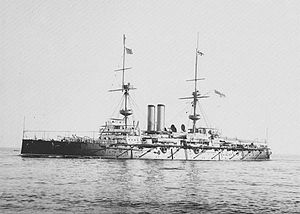 HMS Ramillies
| |
| History | |
|---|---|
| Name | HMS Ramillies |
| Namesake | Battle of Ramillies |
| Builder | J & G Thomson Ltd., Clydebank |
| Laid down | 11 August 1890 |
| Launched | 1 March 1892 |
| Commissioned | 17 October 1893 |
| Decommissioned | August 1911 |
| Fate | Sold for scrapping, 7 October 1913 |
| General characteristics [1] | |
| Class and type | Royal Sovereign-class pre-dreadnought battleship |
| Displacement | |
| Length | 410 ft 5 in (125.10 m) oa |
| Beam | 75 ft (23 m) |
| Draught | 27 ft 6 in (8.38 m) |
| Propulsion | Twin coal-fired Humphreys & Tennant 3-cylinder triple-expansion steam engines, two screws; 9000ihp |
| Speed | 15.7 knots max |
| Complement | 712 |
| Armament |
|
| Armour | |
HMS Ramillies was a Royal Sovereign-class pre-dreadnought battleship of the Royal Navy, named after the Battle of Ramillies. The ship was built by J. & G. Thompson at Clydebank, starting with her keel laying in August 1890. She was launched in March 1892 and commissioned into the Mediterranean Fleet as flagship the following October. She was armed with a main battery of four 13.5-inch guns and a secondary battery of ten 6-inch guns. The ship had a top speed of 16.5 knots.
Ramillies served as flagship of the Mediterranean Fleet up to 1899, and again from 1900 to 1902. After taking part in manoeuvres off the coast of Portugal, she returned to England for a refit in 1903. Upon completion, she was commissioned into the Reserve in 1905. She suffered damage while participating in combined manoeuvres the following year, and was recommissioned into the Special Service Division of the Home Fleet in 1907, becoming the Parent Ship of the 4th Division of the Home Fleet in 1910. She was relieved of that role a year later, before being reduced to material reserve at Devonport in August 1911, and stripped and laid up at Motherbank for disposal in July 1913. She was sold for scrap in October 1913 and towed to Italy to be broken up the following month.